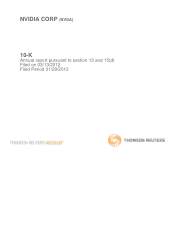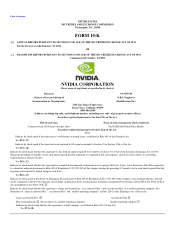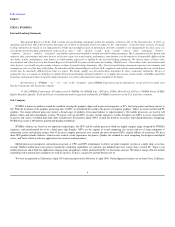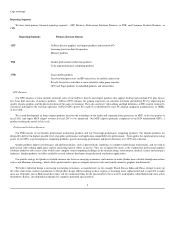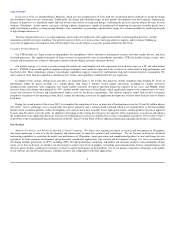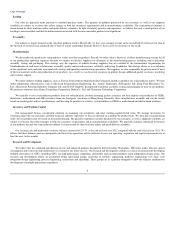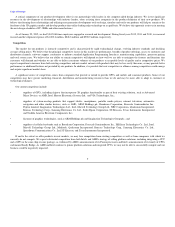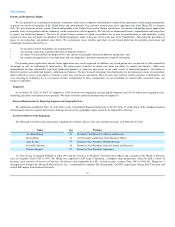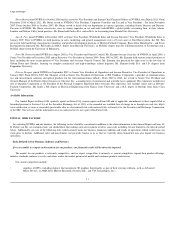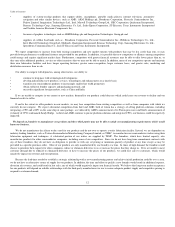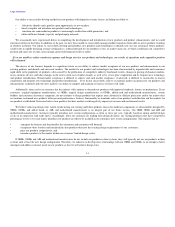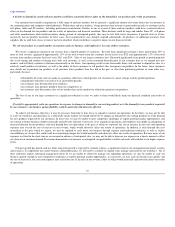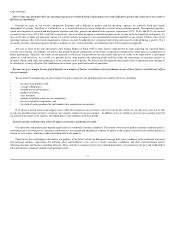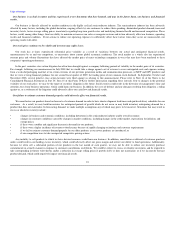NVIDIA 2012 Annual Report Download - page 9
Download and view the complete annual report
Please find page 9 of the 2012 NVIDIA annual report below. You can navigate through the pages in the report by either clicking on the pages listed below, or by using the keyword search tool below to find specific information within the annual report.
Table of Contents
Backlog
Our sales are primarily made pursuant to standard purchase orders. The quantity of products purchased by our customers as well as our shipment
schedules are subject to revisions that reflect changes in both the customers' requirements and in manufacturing availability. The semiconductor industry is
characterized by short lead time orders and quick delivery schedules. In light of industry practice and experience, we believe that only a small portion of our
backlog is non-cancelable and that the dollar amount associated with the non-cancelable portion is not significant.
Seasonality
Our industry is largely focused on the consumer products market. Historically, we have seen stronger revenue in the second half of our fiscal year than in
the first half of our fiscal year, primarily due to back-to-school and holiday demand. However, there can be no assurance of this trend.
Manufacturing
We do not directly manufacture semiconductor wafers used for our products. Instead, we utilize what is known as a fabless manufacturing strategy for all
of our product-line operating segments whereby we employ world-class suppliers for all phases of the manufacturing process, including wafer fabrication,
assembly, testing and packaging. This strategy uses the expertise of industry-leading suppliers that are certified by the International Organization for
Standardization in such areas as fabrication, assembly, quality control and assurance, reliability and testing. In addition, this strategy allows us to avoid many
of the significant costs and risks associated with owning and operating manufacturing operations. Our suppliers are also responsible for procurement of most
of the raw materials used in the production of our products. As a result, we can focus our resources on product design, additional quality assurance, marketing
and customer support.
We utilize industry-leading suppliers, such as Taiwan Semiconductor Manufacturing Company Limited, to produce our semiconductor wafers. We then
utilize independent subcontractors, such as Advanced Semiconductor Engineering, Inc., Amkor Technology, JSI Logistics Ltd., King Yuan Electronics Co.,
Ltd., Siliconware Precision Industries Company Ltd. and STATS ChipPAC Incorporated to perform assembly, testing and packaging of most of our products.
We purchase substrates from Nanya Technology Corporation, IbidenCo., Ltd. and Unimicron Technology Corporation.
We typically receive semiconductor products from our subcontractors, perform incoming quality assurance and then ship the semiconductors to CEMs,
distributors, motherboard and AIB customers from our third-party warehouse in Hong Kong. Generally, these manufacturers assemble and test the boards
based on our design kit and test specifications, and then ship the products to retailers, system builders or OEMs as motherboard and add-in board solutions.
Inventory and Working Capital
Our management focuses considerable attention on managing our inventories and other working-capital-related items. We manage inventories by
communicating with our customers and then using our industry experience to forecast demand on a product-by-product basis. We then place manufacturing
orders for our products that are based on forecasted demand. The quantity of products actually purchased by our customers as well as shipment schedules are
subject to revisions that reflect changes in both the customers' requirements and in manufacturing availability. We generally maintain substantial inventories
of our products because the semiconductor industry is characterized by short lead time orders and quick delivery schedules.
Our existing cash and marketable securities balances increased by 25.7% at the end of fiscal year 2012 compared with the end of fiscal year 2011. We
believe that these balances and our anticipated cash flows from operations will be sufficient to meet our operating, acquisition and capital requirements for at
least the next twelve months.
Research and Development
We believe that the continued introduction of new and enhanced products designed to deliver leading 3D graphics, HD video, audio, ultra-low power
consumption and system-on-chip architectures is essential to our future success. Our research and development strategy is to focus on concurrently developing
multiple generations of GPUs, including GPUs for high-performance computing, and mobile and consumer products using independent design teams. Our
research and development efforts are performed within specialized groups consisting of software engineering, hardware engineering, very large scale
integration design engineering, process engineering, architecture and algorithms. These groups act as a pipeline designed to allow the efficient simultaneous
development of multiple generations of products.
8

